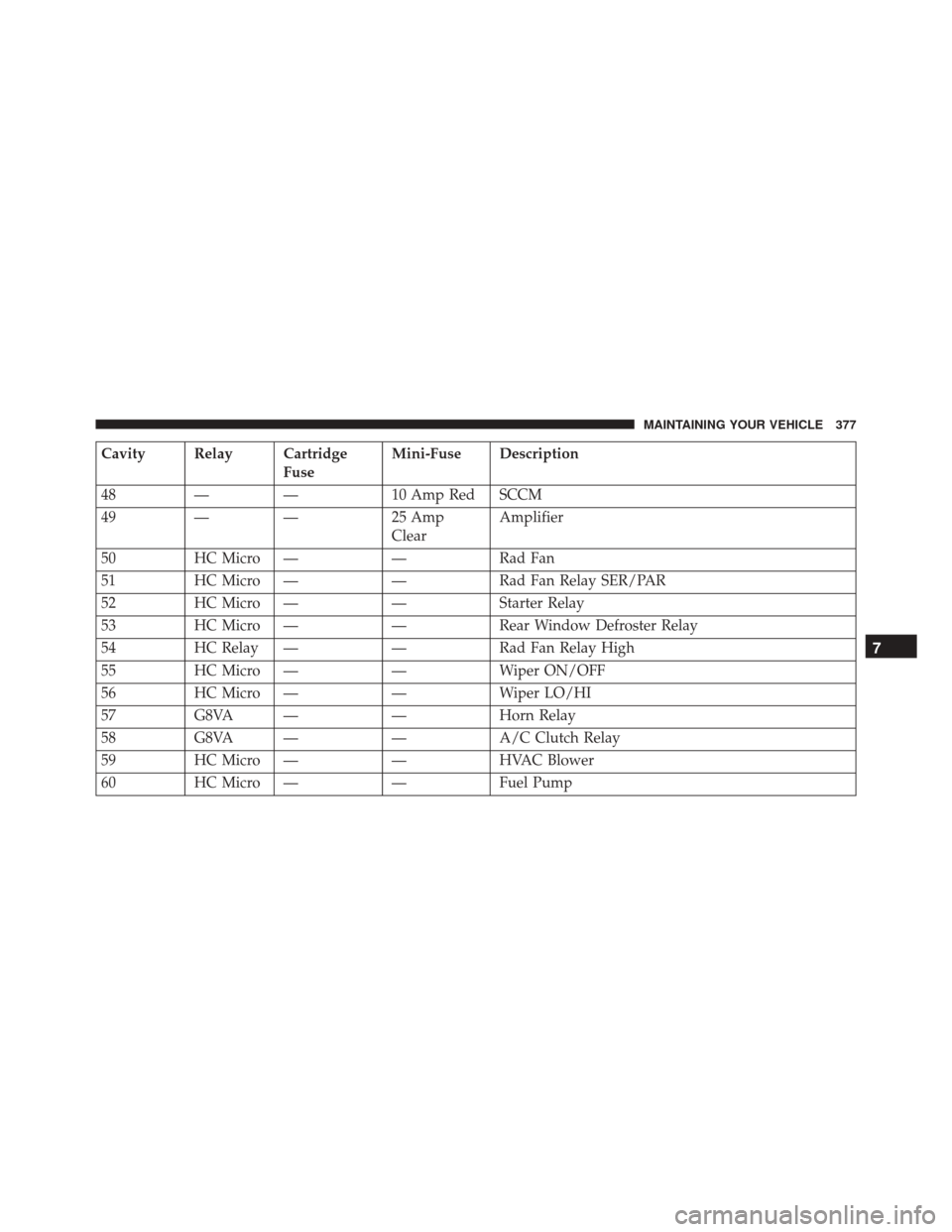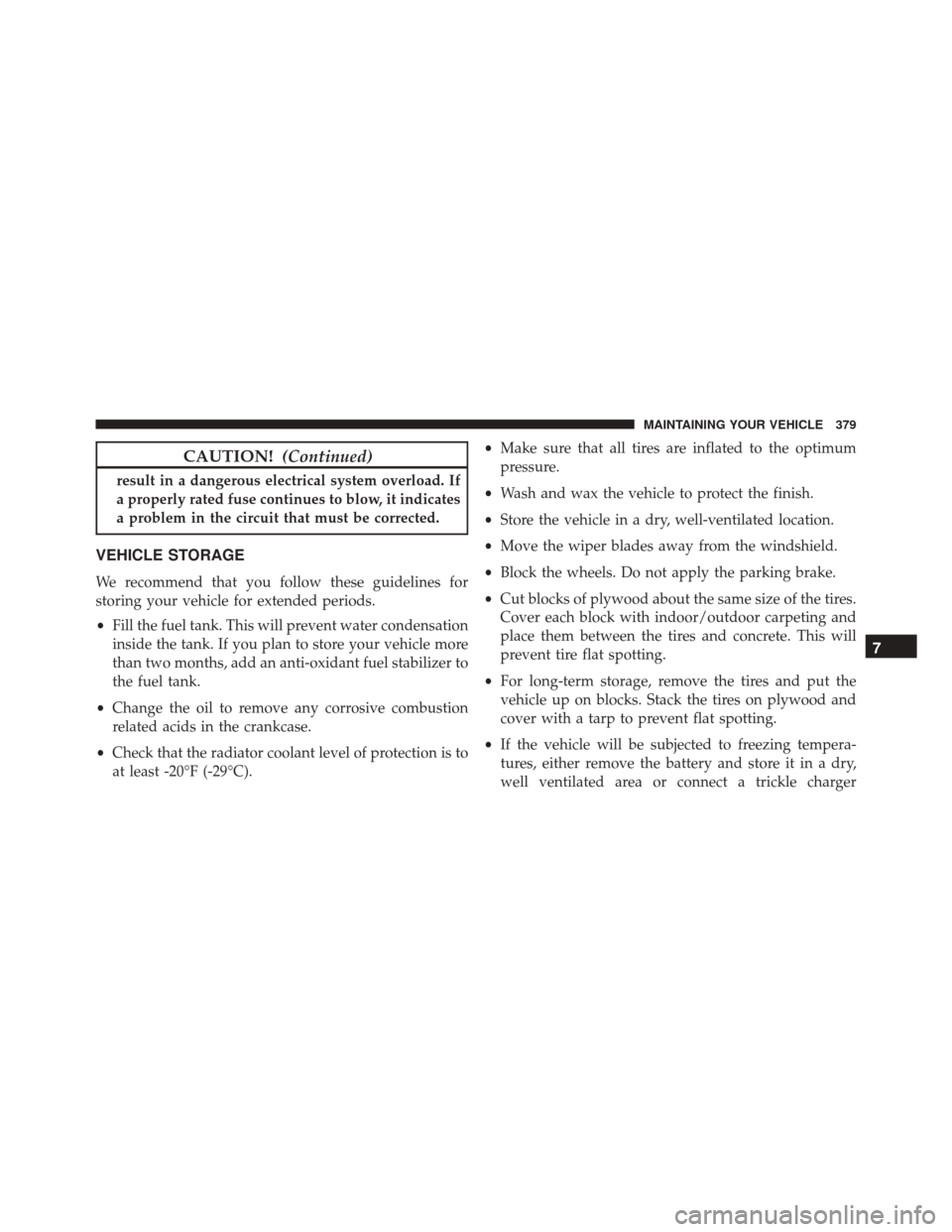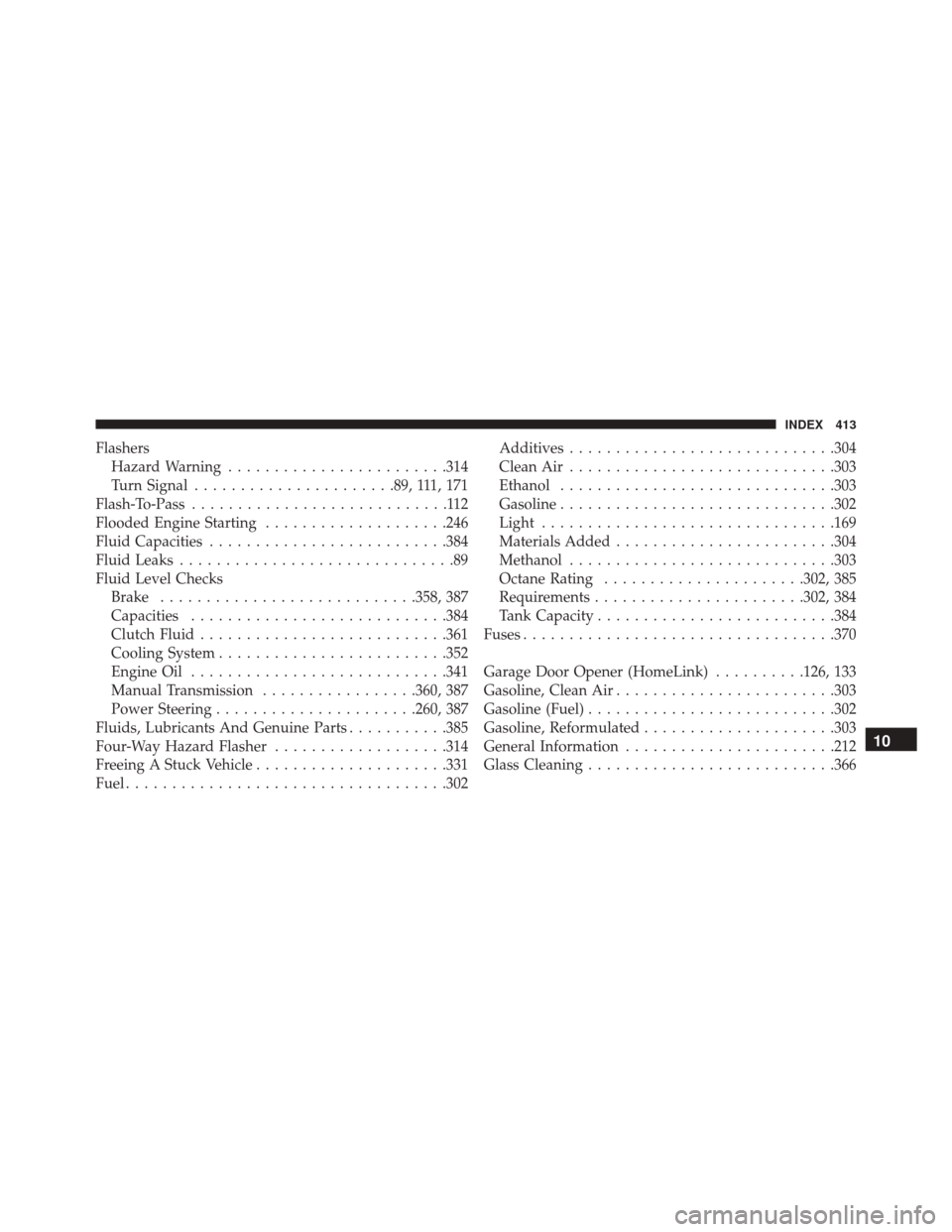fuse DODGE VIPER SRT 2016 VX / 3.G User Guide
[x] Cancel search | Manufacturer: DODGE, Model Year: 2016, Model line: VIPER SRT, Model: DODGE VIPER SRT 2016 VX / 3.GPages: 427, PDF Size: 3.02 MB
Page 379 of 427

Cavity Relay CartridgeFuseMini-Fuse Description
48 — — 10 Amp Red SCCM
49 — — 25 Amp ClearAmplifier
50 HC Micro — — Rad Fan
51 HC Micro — — Rad Fan Relay SER/PAR
52 HC Micro — — Starter Relay
53 HC Micro — — Rear Window Defroster Relay
54 HC Relay — — Rad Fan Relay High
55 HC Micro — — Wiper ON/OFF
56 HC Micro — — Wiper LO/HI
57 G8VA — — Horn Relay
58 G8VA — — A/C Clutch Relay
59 HC Micro — — HVAC Blower
60 HC Micro — — Fuel Pump
7
MAINTAINING YOUR VEHICLE 377
Page 380 of 427

Cavity Relay CartridgeFuseMini-Fuse Description
61 G8VA — — Run Relay #1
62 G8VA — — Run Relay #2
63 HC Micro — —ASD #1
64 HC Micro — —ASD #2
65 G8VA — —Run Accy #1, Pop Up, Driver Door Window Switch
66 —— —Spare
NOTE: A 15 Amp fuse for the radio system is located
in-line at the battery positive terminal.
CAUTION!
• When installing the power distribution center
cover, it is important to ensure the cover is properly
positioned and fully latched. Failure to do so may
(Continued)
CAUTION! (Continued)
allow water to get into the power distribution
center and possibly result in an electrical system
failure.
• When replacing a blown fuse, it is important to use
only a fuse having the correct amperage rating. The
use of a fuse with a rating other than indicated may
(Continued)
378 MAINTAINING YOUR VEHICLE
Page 381 of 427

CAUTION!(Continued)
result in a dangerous electrical system overload. If
a properly rated fuse continues to blow, it indicates
a problem in the circuit that must be corrected.
VEHICLE STORAGE
We recommend that you follow these guidelines for
storing your vehicle for extended periods.
•Fill the fuel tank. This will prevent water condensation
inside the tank. If you plan to store your vehicle more
than two months, add an anti-oxidant fuel stabilizer to
the fuel tank.
• Change the oil to remove any corrosive combustion
related acids in the crankcase.
• Check that the radiator coolant level of protection is to
at least -20°F (-29°C). •
Make sure that all tires are inflated to the optimum
pressure.
• Wash and wax the vehicle to protect the finish.
• Store the vehicle in a dry, well-ventilated location.
• Move the wiper blades away from the windshield.
• Block the wheels. Do not apply the parking brake.
• Cut blocks of plywood about the same size of the tires.
Cover each block with indoor/outdoor carpeting and
place them between the tires and concrete. This will
prevent tire flat spotting.
• For long-term storage, remove the tires and put the
vehicle up on blocks. Stack the tires on plywood and
cover with a tarp to prevent flat spotting.
• If the vehicle will be subjected to freezing tempera-
tures, either remove the battery and store it in a dry,
well ventilated area or connect a trickle charger
7
MAINTAINING YOUR VEHICLE 379
Page 415 of 427

FlashersHazard Warning ....................... .314
Turn Signal ..................... .89, 111, 171
Flash-To-Pass ............................112
Flooded Engine Starting ....................246
Fluid Capacities ......................... .384
Fluid Leaks ..............................89
Fluid Level Checks Brake ........................... .358, 387
Capacities ........................... .384
Clutch Fluid .......................... .361
Cooling System ........................ .352
Engine Oil ........................... .341
Manual Transmission .................360, 387
Power Steering ..................... .260, 387
Fluids, Lubricants And Genuine Parts ...........385
Four-Way Hazard Flasher ...................314
Freeing A Stuck Vehicle .....................331
Fuel .................................. .302Additives
............................ .304
Clean Air ............................ .303
Ethanol ............................. .303
Gasoline ............................. .302
Light ............................... .169
Materials Added ....................... .304
Methanol ............................ .303
Octane Rating ..................... .302, 385
Requirements ...................... .302, 384
Tank Capacity ......................... .384
Fuses ................................. .370
Garage Door Opener (HomeLink) ..........126, 133
Gasoline, Clean Air ....................... .303
Gasoline (Fuel) .......................... .302
Gasoline, Reformulated .....................303
General Information ...................... .212
Glass Cleaning .......................... .366
10
INDEX 413
Page 426 of 427

INSTALLATION OF RADIO TRANSMITTING
EQUIPMENTSpecial design considerations are incorporated into this
vehicle’s electronic system to provide immunity to radio
frequency signals. Mobile two-way radios and telephone
equipment must be installed properly by trained person-
nel. The following must be observed during installation.
The positive power connection should be made directly
to the battery and fused as close to the battery as possible.
The negative power connection should be made to body
sheet metal adjacent to the negative battery connection.
This connection should not be fused.
Antennas for two-way radios should be mounted on the
roof or the rear area of the vehicle. Care should be used
in mounting antennas with magnet bases. Magnets may
affect the accuracy or operation of the compass on
vehicles so equipped.The antenna cable should be as short as practical and
routed away from the vehicle wiring when possible. Use
only fully shielded coaxial cable.
Carefully match the antenna and cable to the radio to
ensure a low Standing Wave Ratio (SWR).
Mobile radio equipment with output power greater than
normal may require special precautions.
All installations should be checked for possible interfer-
ence between the communications equipment and the
vehicle’s electronic systems.